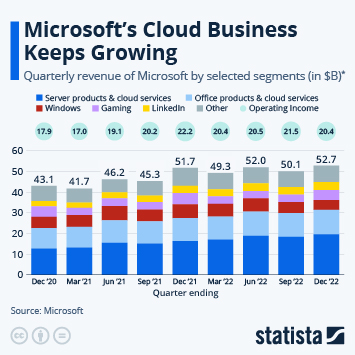Even though Microsoft's best-known front-facing product might be its productivity suite Microsoft 365, cloud services and properties have been integral to the company's success over the last couple of years. Out of $118.5 billion generated between July and December 2023, cloud computing was responsible for $65.5 billion or 55 percent of its total revenue. This marks a continuation of the trend of cloud solutions slowly but surely overtaking Microsoft's other products in terms of their fiscal importance.
As our chart based on company data shows, sales linked to cloud services and properties like Azure, Dynamics 365 and the commercial portions of LinkedIn and Office 365 amounted to 41 percent of the company's total revenue between July and December 2021. For the same period of 2022, this share rose to 46 percent.
While the increased tendency for companies to shift from on-premise to cloud solutions is one likely reason for this increase, the doubling of its cloud revenue from its first and second fiscal quarters of 2021 to the same period for 2024 might also be explained by Microsoft's decision to intensify its partnership with and invest a further $13 billion into OpenAI in January 2023.
The goal set by both companies was to gradually integrate the AI startup's large language model GPT-4 into every Microsoft product, with various solutions already available on many major Microsoft platforms like its operating system Windows 11, Microsoft 365 for Enterprise, GitHub and Bing. Since this cooperation also entails hosting OpenAI's offerings on Azure cloud instances, Microsoft's cloud revenue is bound to become an even more crucial company pillar in the future.
According to estimates by Gartner, end users will spend approximately $679 billion on public cloud services in 2024. The major players in the market are Microsoft and Amazon's AWS and Google Cloud.





















